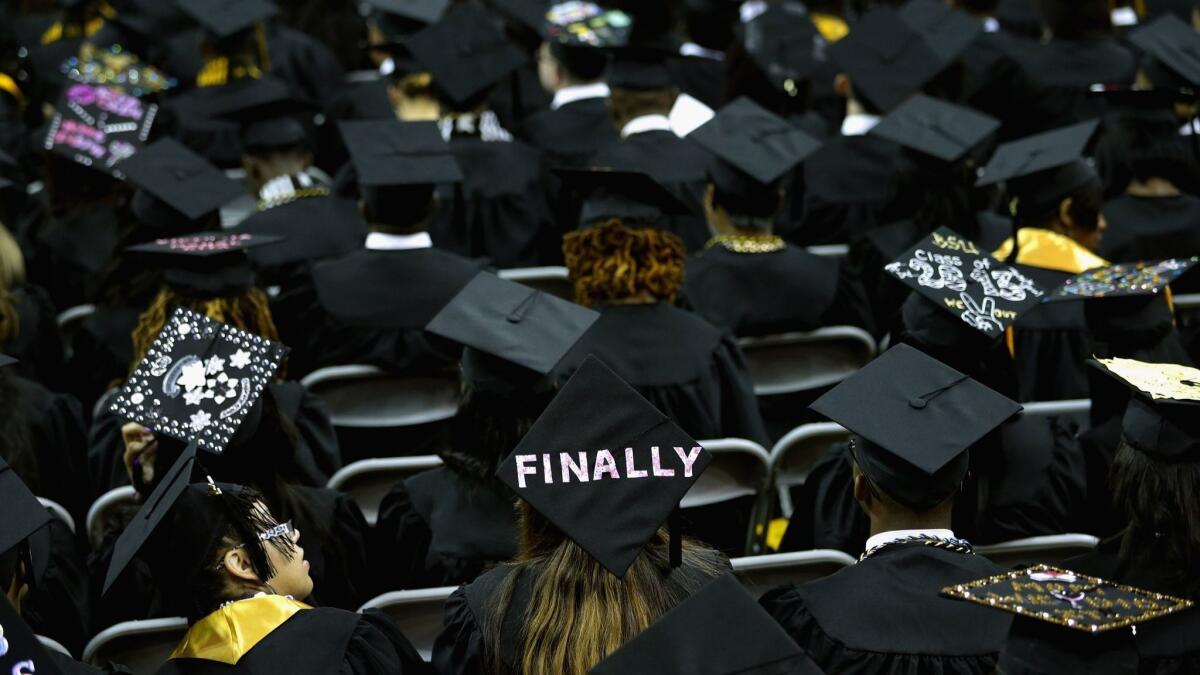Student loans are forcing young graduates to put off settling down

- Share via
It’s that time of year, when students prepare to head back to the classroom. For many taking the next step in higher education, the question is increasingly, “Is it worth it?” Millions of millennials have already put off settling down because of the rising costs of servicing college debts, to the detriment of economic growth.
Student loans are now the second-largest category of household debt in America, topping $1.4 trillion and trailing only mortgages at $9 trillion. And while Korn Ferry puts the average starting salary for a 2018 college graduate at $50,390, up 2.8% from 2017, the just-released July consumer price index report shows the inflation rate rose 2.9% over the last 12 months. Does the phrase “treading water” come to mind?
A recent report by Bloom Economic Research breaks out the demographic challenges that have resulted from the 176% increase in student loan debt in the decade through 2017. In the years of dramatic loosening of mortgage credit standards leading up to the housing crisis, many families tapped readily available home equity to finance pricier higher educations for their children than they would have otherwise been able to afford. After the bust, this avenue was blocked, leaving only the higher education inflation it had fueled.
From 2007 through 2017, the CPI rose 21%. Over that same period, college tuition costs jumped 63%, school housing surged 51% and the price of textbooks rose 88%. These troubling growth rates wipe away any mystery behind today’s staggering levels of student loan debt, which has almost tripled from the 2007 starting point of $545 billion. As of the fourth quarter, student loans represented 10.5% of a record $13.1 trillion in U.S. household debt, up from 3.3% at the start of 2003.
Regardless of income bracket, housing is the biggest line item in family budgets. According to RentCafe, the average rent in the U.S. was a record $1,409 in July, a 2.8% rise from a year earlier.
While rent growth has stopped outpacing gains in salaries, the level is nevertheless prohibitively high for many, especially those weighed down by student loans the minute they cross the stage. The average student loan payment is $351. Tack that on to average rents and you’re pushing $1,800 before you hit the online grocery app icon on your smartphone, the bill for which runs at least $100 a month for most of us. Using college grad starting salaries, that takes up a large chunk of the monthly take-home pay of about $3,400 if you live in Texas or $3,100 if you’re in New York.
The latest demographic breakdown available has an end point of 2016. What we know through that period is that 22.4% of all U.S. households carried student debt, with the percentage rising to 44.8% for those 18 to 34, up from 18.6% in 2001.
The average household has to save for almost 6½ years to cover a 20% down payment on a home at current prices, according to a recent study by Zillow’s HotPads. That’s based on the steep assumption that workers can sock away 20% of their monthly take-home pay.
The outer birth-year band for millennials is 1981, meaning millennials are starting to be closer to 40 than they are to 30. While home ownership has picked up, it’s been held back for a decade by stagnant wage growth coupled with onerous debt burdens. The macroeconomic ramifications are well-documented. Baby boomers house a record level of their millennial offspring who can’t afford to leave home. Birth rates have fallen to a 30-year low as marriage is put off.
Clearly, reform of some kind must address the issue of student debt, which is not to say debt relief or outright forgiveness. Institutions of higher learning in this country must take some of the responsibility for the current state of affairs in the nation’s most populous demographic group. And while the misguided cultural stigmatization of vocational education appears to finally be abating, further inroads to reintroduce balance to the workforce must be made.
The return on investment in a four-year degree isn’t as straightforward as it was for high school grads circa 1988. The reality of cost burdens must be weighed against the quality of life millions have forgone thanks to the ease with which they’ve been able to finance the higher educations that have relegated their lives to lower rungs.
Danielle DiMartino Booth, a former advisor to the president of the Dallas Federal Reserve, wrote this for Bloomberg Opinion. She is the author of “Fed Up: An Insider’s Take on Why the Federal Reserve Is Bad for America” and founder of Quill Intelligence.
»
More to Read
Inside the business of entertainment
The Wide Shot brings you news, analysis and insights on everything from streaming wars to production — and what it all means for the future.
You may occasionally receive promotional content from the Los Angeles Times.










